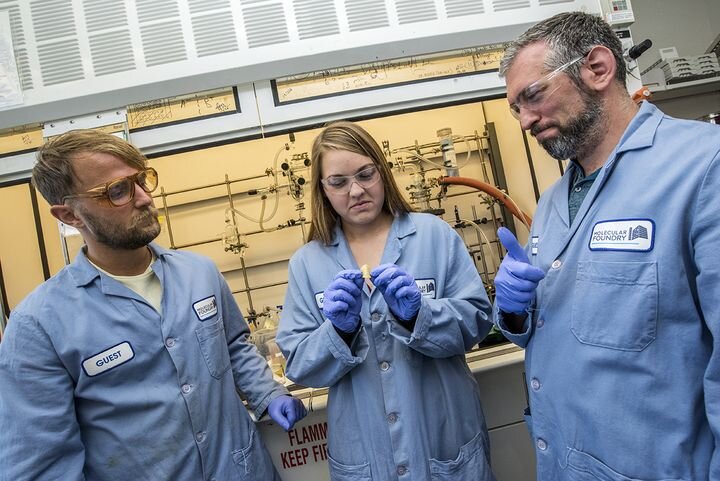![Peter Christensen, Kathryn Loeffler, and Brett Helms at Berkeley Lab [Source: Marilyn Chung/Berkeley Lab]](https://fabbaloo.com/wp-content/uploads/2020/05/image-asset_img_5eb08c151b1c6.jpg)
The future of 3D printing could involve PDK filament material.
What, you haven’t heard of PDK? I hadn’t either until I read a piece by Berkeley Lab describing some new research they’ve been doing to develop a new kind of ultra-recyclable thermoplastic.
Why is this needed? The researchers claim the rate of recycling, even for the current spectrum of supposedly-recyclable plastics is very poor. They say:
“Because plastics contain various additives, like dyes, fillers, or flame retardants, very few plastics can be recycled without loss in performance or aesthetics. Even the most recyclable plastic, PET – or poly(ethylene terephthalate) – is only recycled at a rate of 20-30%, with the rest typically going to incinerators or landfills, where the carbon-rich material takes centuries to decompose.”
3D Printer Filament Recycling?
As we all know, 3D printer filaments, particularly those emerging recently, are filled with all kinds of colors and additives to differentiate them among the vast number of material providers now worldwide.
This makes is incredibly challenging to recycle materials as you must find waste objects made from literally identical polymer formulations. And even then you must ensure the same additives were used.
Are the objects the same color? No: they can’t be mixed in a recycler and have any hope of knowing what you’re getting out the other end. Manufacturing depends on repeatability, and a big part of that is ensuring the input material is identical for every run through.
The supposedly recyclable materials really are not. Eighty percent of those failed 3D prints you’re hoarding are going to the landfill.
PDK Plastic
The material under research at Berkeley Lab is called PDK, short for poly(diketoenamine), and it has an extremely interesting and likely valuable property: it can be fully recycled, and easily so.
It’s a polymer, which is a molecular construction of smaller monomers. These complex molecular arrangements are what makes specific polymers different from each other.
![Depolymerized plastics [Source: Peter Christensen et al./Berkeley Lab]](https://fabbaloo.com/wp-content/uploads/2020/05/depolymerized-plastic-690x421_img_5eb08c1564a6c.jpg)
Unlike conventional plastics, the monomers of PDK plastic could be recovered and freed from any compounded additives simply by dunking the material in a highly acidic solution. (
The researchers discovered that PDK can, when exposed to an acidic solution, be broken down into its original monomers — separate from the additives. Through some subsequent steps, these monomers can be easily recovered and then re-made back into raw PDK. This PDK can then be infused with additives to achieve desired engineering properties.
PDK Filament?
While I am pretty sure there are no spools of PDK filament in existence, it could be interesting to speculate what might happen if they did.
There would instantly be an opportunity for true 3D print recycling. Scrap prints could be collected and processed back into usable filament or other PDK products. It might even be possible to SELL scrap 3D prints to recyclers, depending on how the economics works out.
Here’s hoping we see PDK filament appear in the near future!
Via LBL

